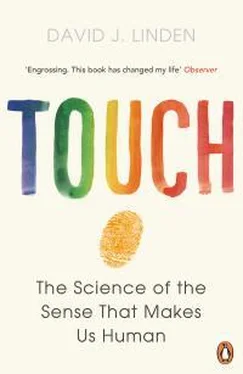14. The observation that the foot, the nipple, and the genitals activate adjacent patches of primary somatosensory cortex has led some to suggest that cross talk between these regions might help explain the prevalence of foot-fetish sexual behavior. There’s no evidence that speaks strongly either for or against this notion. However, it should be noted that seizures involving the foot part of the map, in the mesial surface of the postcentral gyrus, can produce sensations in the nipples, labia minora, and feet of women.
15. Indeed, the notion of penis-vagina intercourse without male orgasm has a long history in many cultures. It is called coitus reservatus in the European tradition and cai yin pu yang in the Taoist tradition. Cai yin pu yang means gathering and absorbing female essence (yin) by the male. Similarly, the practice of karezza , in which penis-vagina intercourse is controlled to bring both male and female partners near to orgasm, is promoted as a way of achieving mystical sexual ecstasy.
16. The idea of using a pleasure trajectory to compare sexual behavior with eating came from the following review article, which is worth a read if you’d like to dig into some technical details, particularly about how human sex compares to that of critters: J. R. Georgiadis, M. L. Kringelbach, and J. G. Pfaus, “Sex for fun: a synthesis of human and animal neurobiology,” Nature Reviews Urology 9 (2012): 486–98.
17. There’s a clear and compassionate FAQ about sex and spinal cord injury at http://www.sexsci.me/FAQ/.
18. For a more extended discussion of this topic, see my book The Compass of Pleasure (New York: Viking/Penguin, 2011), 105–11. For a complete meta-analysis of the scientific work on this topic, see M. L. Chivers, M. C. Seto, M. L. Lalumiere, E. Lann, and T. Grimbos, “Agreement of self-reported and genital measures of sexual arousal in men and women: a meta-analysis,” Archives of Sexual Behavior 39 (2010): 5–56.
19. http://www.tampabay.com/features/humaninterest/persistent-genital-arousal-disorder-brings-woman-agony-not-ecstasy/1263980, story written by Leonora LaPeter Anton.
20. PGAD was originally called persistent sexual arousal syndrome (PSAS) until it was realized that it was a misnomer: It is not associated with any increase in sexual arousal or desire. Another name for this condition is “restless genital syndrome,” reinforcing the presumed link to restless leg syndrome. For a recent review of the literature on PGAD, see T. M. Facelle, H. Sadeghi-Nejad, and D. Goldmeir, “Persistent genital arousal disorder: characterization, etiology, and management,” Journal of Sexual Medicine 10 (2013): 439–50.
21. J. Money, G. Wainwright, and D. Hingburger, The Breathless Orgasm: A Lovemap Biography of Asphyxiophilia (New York: Prometheus Books, 1991).
22. All this rapture and ecstasy means that orgasm has attracted the attention of religious authorities. On the one hand, orgasm has been seen as life-affirming and healthy. On the other hand, at least for men, orgasm can be viewed as debilitating, a loss of male energy and essence. Havelock Ellis, writing in 1910, reported the following recommended frequencies for male orgasm (female orgasm was not addressed): Hindu Authorities: three to six times per month; Martin Luther: twice per week; the Holy Koran: once per week; the Talmud: once per day to once per week depending upon one’s occupation. H. Ellis, Studies in the Psychology of Sex (London: F. A. Davis, 1910).
23. For a comprehensive overview of this topic, see B. R. Komisaruk and B. Whipple, “Non-genital orgasms,” Sexual and Relationship Therapy 26 (2011): 356–72. And for all of your many orgasm questions, I recommend this useful book: B. R. Komisaruk, B. Whipple, S. Naserzadeh, and C. Beyer-Flores, The Orgasm Answer Guide (Baltimore: Johns Hopkins University Press, 2010).
24. Some people can even have an orgasm from a hug while fully clothed. They are just wired that way.
25. J. Money, “Phantom orgasm in the dreams of paraplegic men and women,” Archives of General Psychiatry 3 (1960): 373–82.
26. E. B. Vance and N. N. Wagner, “Written descriptions of orgasms: a study of sex differences,” Archives of Sexual Behavior 5 (1976): 87–98.
27. S. K. Fistarol and P. H. Itin, “Diagnosis and treatment of lichen sclerosus: an update,” American Journal of Clinical Dermatology 14 (2013): 27–47. Here is a useful informational Web site for people with lichen sclerosus: http://www.lichensclerosus.net/.
28. You can read Koedt’s essay here: http://www.uic.edu/orgs/cwluherstory/CWLUArchive/vaginalmyth.html.
29. A. C. Kinsey, Sexual Behavior in the Human Female ( New York: Pocket Books, 1953), 580 .
30. Another structure on the anterior vaginal wall is the “G-spot,” which has been proposed to play a special role in female sexual sensation. At present, the question of whether the G-spot is a well-defined anatomical entity is unresolved. For example, examination of tissue sections from cadavers has led to different conclusions by various researchers. If you’d like to read a recent review article exploring the controversy, see E. A. Jannini, B. Whipple, S. A. Kingsberg, O. Buisson, P. Foldès, and Y. Vardi, “Who’s afraid of the G-spot?” Journal of Sexual Medicine 7 (2010): 25–34.
31. E. A. Jannini, A. Bubio-Casillas, B. Whipple, O. Buisson, B. Komisaruk, and S. Brody, “Female orgasm(s): one, two, several,” Journal of Sexual Medicine 9 (2012): 956–65.
32. While we normally think of erection as being a prerequisite for orgasm, this is not entirely correct. For example, if the pudendal arteries become blocked, erection cannot occur, but stimulation of the penis can still produce orgasm in some cases.
33. M. Koeman, M. F. Van Driel, W. C. M. Weijmar Schultz, and H. J. A. Mensink, “Orgasm after radical prostatectomy,” British Journal of Urology 77 (1996): 861–64.
34. And don’t imagine that it’s only gay or bisexual men who like stimulation of the anus, rectum, and prostate. My old pal C., who runs an Internet sex-toy shop, says, “You’ll never go broke selling devices for straight guys to put in their butts.”
35. G. Holstege, J. R. Georgiadis, A. M. J. Paans, L. C. Meiners, F. H. C. E. van der Graaf, and A. A. T. S. Reinders, “Brain activation during human male ejaculation,” Journal of Neuroscience 23 (2003): 9185–93; J. R. Georgiadis and G. Holstege, “Human brain stimulation during sexual stimulation of the penis,” Journal of Comparative Neurology 493 (2005): 33–38; and J. R. Georgiadis, R. Kortekaas, R. Kuipers, A. Nieuwenburg, J. Pruim, A. A. T. S. Reinders, and G. Holstege, “Regional cerebral blood flow changes associated with clitorally induced orgasm in healthy women,” European Journal of Neuroscience 24 (2006): 3305–16.
36. The amygdala is best known for processing signals related to fear, but it also has roles in other types of emotional processing and learning.
37. J. Calleja, R. Carpizo, and J. Berciano, “Orgasmic epilepsy,” Epilepsia 29 (1988): 635–39; Y. C. Chuang, T. K. Lin, C. C. Lui, S. D. Chen, and C. S. Chang, “Tooth-brushing epilepsy with ictal orgasms,” Seizure 13 (2004): 179–82; and G. M. Remillard, F. Andermann, G. F. Testa, P. Gloor, M. Aube, J. B. Martin, W. Feindel, A. Guberman, and C. Simpson, “Sexual ictal manifestations predominate in women with temporal lobe epilepsy: a finding suggesting sexual dimorphism in the human brain,” Neurology 33 (1983): 323–30.
CHAPTER FIVE: HOT CHILI PEPPERS, COOL MINT, AND VAMPIRE BATS
1. Chili peppers are the seedpods of five different cultivated species of the genus Capsicum . Archeological digs have indicated that people in present-day Mexico were eating chili peppers as early as six thousand years ago. Chili peppers were brought from the West Indies to Europe by Diego Álvarez Chanca, who was a doctor on Columbus’s second voyage in 1493. Europeans, Africans, and Asians had black pepper in pre-Columbian times, but this is different from chili pepper. Black and white peppers come from the berries of the pepper plant Piper nigrum , which originated in south India. Black peppercorns are made by picking the pepper berries when they are partially ripe and then leaving them to dry. White peppercorns are picked when very ripe and subsequently soaked in brine to remove their dark outer shell, leaving only the white pepper seed. The main pungent compound from black pepper is piperene, which is chemically and functionally distinct from that of chili peppers. Some people in Asia during pre-Columbian times also made use of the seeds of the plants Zanthoxylum simulans and Zanthoxylum bungeanum , now known as Szechuan pepper. Szechuan peppercorns evoke a tingling, numbing sensation produced by its active ingredient, alpha-sanshool. Like black pepper, Szechuan pepper is chemically and experientially distinct from chili pepper.
Читать дальше












